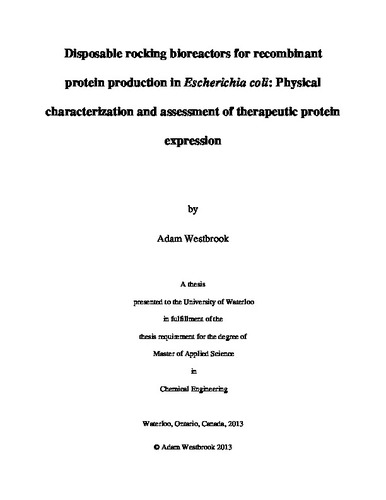| dc.description.abstract | Disposable technology has gained increasing acceptance in the biopharmaceutical industry over the last decade, and provides many advantages over conventional stainless steel equipment. Disposable rocking bioreactors (RBs) are widely employed for cultivation of recombinant mammalian and insect cell lines, although the perception of inadequate mass transfer has prevented their application to bioprocesses based on microbial platforms. In an effort to thoroughly evaluate the suitability of disposable RBs for cultivation of aerobic microorganisms, a comparative study of one-dimensional (1D) and two-dimensional (2D) disposable RBs, and the conventional stirred tank reactor (STR) was performed. The comparison involved: 1) physical characterization of oxygen mass transfer efficiency and mixing intensity, 2) batch cultivation of Escherichia coli BL21 for comparison of growth characteristics, and 3) batch cultivation of recombinant E. coli BL21 expressing a clinical therapeutic, hCD83ext (the extracytoplasmic domain of human CD83). Oxygen mass transfer (evaluated as the mass transfer coefficient, kLa) was comparable between the 1D RB and STR (approximately 150 h-1) at low working volume (WV), declining linearly with increasing WV, while kLa was highest in the 2D RB for all tested WVs, providing the maximum kLa (394 h-1) at 3 L WV. Fast mixing (t95 of 8-20 s) was observed in all three systems for water and aqueous carboxymethylcellulose (CMC) solutions. Batch growth characteristics of E. coli BL21 were similar in each system, although acetate accumulation was significant in the 1D RB. Batch production of GST-hCD83ext (glutathione S-transferase-hCD83ext fusion protein) resulted in similar soluble protein yields and inclusion body formation between bioreactors. Although cell growth and protein expression were comparable between all bioreactors, the 1D RB is not considered a suitable cultivation system for E. coli under experimental conditions given the significant acetate accumulation observed and high supplemental oxygen requirement for low cell density cultures. On the other hand, considering its formidable mass transfer capacity and overall performance in batch cultivations, the CELL-tainer® is an attractive alternative to the STR for cultivation of recombinant E. coli expressing high value therapeutic proteins. | en |

